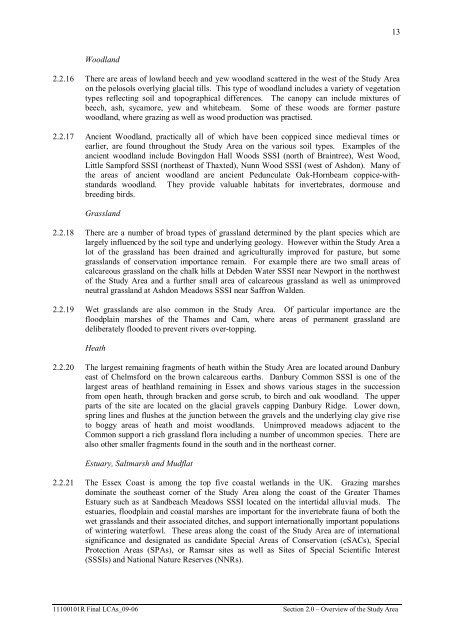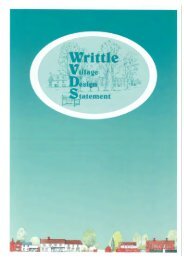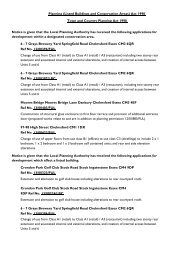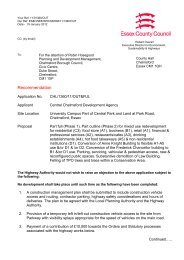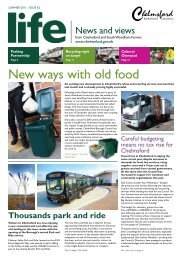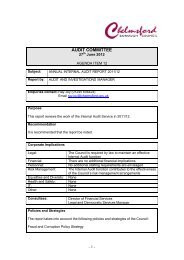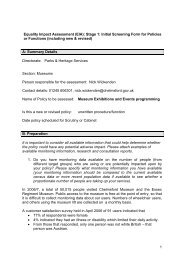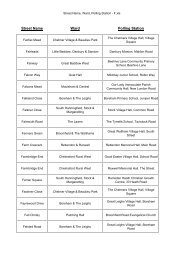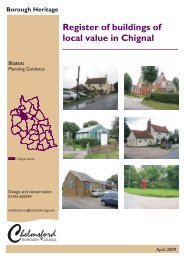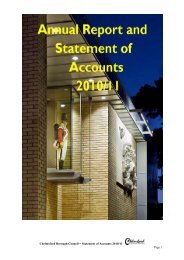122.2.8 On the hills above the London Clay, the capping of the fine sands of the Bagshot Beds by thepebbly clay drifts have led to acidic soils with low natural fertility that are easily cultivated.2.2.9 In the northwest of the Study Area, the geology changes to glacial tills composed of sandsand gravels overlain by the most extensive soils in the area, pelosols. These are heavy acidicsoils often prone to waterlogging in winter months and to shrinking and cracking in summerresulting in a predominance of pasture fields on the low hills and ridges.2.2.10 In the northwest of Uttlesford, the altitude reaches just over 130m AOD to the west ofSaffron Walden. In this area the chalk is exposed at the surface and has given the area itscharacteristic rolling topography and free draining poor alkaline soils that support widespreadcereal farming.2.2.11 The Study Area has a large intricate network of rivers and streams. These are an importantcomponent of the area’s topography, character and identity and are frequently of landscape,nature conservation and heritage value. To the north the valleys become steeper and moredeeply cut.2.2.12 Most of the rivers flow towards either the Thames or the North Sea (see Figure 2.2). Onlythe Cam flows northward. Principal rivers within the Study Area are the Stour, Colne,Blackwater, Chelmer and Crouch. The Colne, Blackwater, Chelmer and tributaries rise in theplateau to the north and flow south where their estuaries are extensive and contribute to thedeeply indented coastline. The Crouch flows east across the undulating lowland to the southof the plateau and when joined by the Roach forms an estuary complex that includes theislands of Wallasea, Potton and Foulness.2.2.13 The coastline is mainly marshland and is characterised by a maze of winding shallow creeks,drowned estuaries, mudflats and broad tracts of tidal salt-marsh with sand and shinglebeaches along the coast edge. The relatively permanent, branching, meandering creeks,dissect the salt marshes.Landcover and Ecological <strong>Character</strong>2.2.14 The rural landscape of the Study Area is predominantly used for arable or improved pasture,particularly on the flat or gently undulating land. The rich soils are intensively cultivated andlarge cereal fields are a major feature of the landscape. The cereal field margins occasionallysupport uncommon plants such as cornflower, broad-leaved cudweed, corn cleavers andshepherd’s needle.2.2.15 There are significant areas of remaining semi-natural habitat that make an importantcontribution to the area’s distinctive character. The presence and distribution of thesehabitats is strongly influenced by geology and landform, and include woodland, grassland,heath, estuary, saltmarsh and mudflat and freshwater and open water habitats. Many siteswhere these habitats occur are designated as Ramsar Sites, candidate Special Areas ofConservation (cSAC), Sites of Special Scientific Interest (SSSI), Sites of Importance forNature Conservation (SINCs) 1 , Special Protection Areas (SPA), National Nature Reserves(NNR) and/or Local Nature Reserves (LNR). The distribution of these areas designated fortheir nature conservation value are shown on Figure 2.3 and described below in relation tokey habitat types.1 SINCs are also referred to as County Wildlife Sties, which will become known as Local Wildlife Sites in duecourse.Section 2.0 – Overview of the Study Area11100101R Final LCAs_09-06
13Woodland2.2.16 There are areas of lowland beech and yew woodland scattered in the west of the Study Areaon the pelosols overlying glacial tills. This type of woodland includes a variety of vegetationtypes reflecting soil and topographical differences. The canopy can include mixtures ofbeech, ash, sycamore, yew and whitebeam. Some of these woods are former pasturewoodland, where grazing as well as wood production was practised.2.2.17 Ancient Woodland, practically all of which have been coppiced since medieval times orearlier, are found throughout the Study Area on the various soil types. Examples of theancient woodland include Bovingdon Hall Woods SSSI (north of Braintree), West Wood,Little Sampford SSSI (northeast of Thaxted), Nunn Wood SSSI (west of Ashdon). Many ofthe areas of ancient woodland are ancient Pedunculate Oak-Hornbeam coppice-withstandardswoodland. They provide valuable habitats for invertebrates, dormouse andbreeding birds.Grassland2.2.18 There are a number of broad types of grassland determined by the plant species which arelargely influenced by the soil type and underlying geology. However within the Study Area alot of the grassland has been drained and agriculturally improved for pasture, but somegrasslands of conservation importance remain. For example there are two small areas ofcalcareous grassland on the chalk hills at Debden Water SSSI near Newport in the northwestof the Study Area and a further small area of calcareous grassland as well as unimprovedneutral grassland at Ashdon Meadows SSSI near Saffron Walden.2.2.19 Wet grasslands are also common in the Study Area. Of particular importance are thefloodplain marshes of the Thames and Cam, where areas of permanent grassland aredeliberately flooded to prevent rivers over-topping.Heath2.2.20 The largest remaining fragments of heath within the Study Area are located around Danburyeast of <strong>Chelmsford</strong> on the brown calcareous earths. Danbury Common SSSI is one of thelargest areas of heathland remaining in Essex and shows various stages in the successionfrom open heath, through bracken and gorse scrub, to birch and oak woodland. The upperparts of the site are located on the glacial gravels capping Danbury Ridge. Lower down,spring lines and flushes at the junction between the gravels and the underlying clay give riseto boggy areas of heath and moist woodlands. Unimproved meadows adjacent to theCommon support a rich grassland flora including a number of uncommon species. There arealso other smaller fragments found in the south and in the northeast corner.Estuary, Saltmarsh and Mudflat2.2.21 The Essex Coast is among the top five coastal wetlands in the UK. Grazing marshesdominate the southeast corner of the Study Area along the coast of the Greater ThamesEstuary such as at Sandbeach Meadows SSSI located on the intertidal alluvial muds. Theestuaries, floodplain and coastal marshes are important for the invertebrate fauna of both thewet grasslands and their associated ditches, and support internationally important populationsof wintering waterfowl. These areas along the coast of the Study Area are of internationalsignificance and designated as candidate Special Areas of Conservation (cSACs), SpecialProtection Areas (SPAs), or Ramsar sites as well as Sites of Special Scientific Interest(SSSIs) and National Nature Reserves (NNRs).11100101R Final LCAs_09-06Section 2.0 – Overview of the Study Area
- Page 1: BRAINTREE, BRENTWOOD, CHELMSFORD,MA
- Page 6 and 7: 8.0 RECOMMENDATIONS8.1 General8.2 K
- Page 8 and 9: EXECUTIVE SUMMARYBackgroundIn Octob
- Page 10 and 11: Executive Summary iv 11100101R Fina
- Page 13 and 14: 11.0 INTRODUCTION1.1 Background and
- Page 15 and 16: 3spatial planning approach should b
- Page 17 and 18: 5Proposals Map - expresses geograph
- Page 19 and 20: 7 View types and composition Landma
- Page 21 and 22: 9 the highlighting of landscape iss
- Page 23: 2.0 OVERVIEW OF THE STUDY AREA
- Page 28 and 29: 142.2.22 The Essex Estuaries cSAC i
- Page 30 and 31: 16and have been found to have been
- Page 32 and 33: 18 Medieval settlement, in the pari
- Page 34 and 35: 20Historic Environment Designations
- Page 36 and 37: 22and drainage of other coastal wet
- Page 38 and 39: 24character. Upgrading of the rail
- Page 40 and 41: 26alternative sources from outside
- Page 42 and 43: 282.5.7 Together with the Joint Cha
- Page 44 and 45: 302.5.13 The seventy Landscape Char
- Page 46 and 47: 32Section 2.0 - Overview of the Stu
- Page 49 and 50: 1395.0 LANDSCAPE CHARACTER OF CHELM
- Page 51 and 52: 141A6 UPPER CHELMER RIVER VALLEY (s
- Page 53 and 54: 143 Fourteen CWSs with unimproved g
- Page 55 and 56: 145A7 LOWER CHELMER RIVER VALLEY (s
- Page 57 and 58: 147Suggested Landscape Planning Gui
- Page 59 and 60: 149to designed character and sense
- Page 61 and 62: 1515.3 Farmland Plateau Landscapes5
- Page 63 and 64: 153and Good Easter in the lower lyi
- Page 65 and 66: 155B16 FELSTED FARMLAND PLATEAU (sh
- Page 67 and 68: 157B17 TERLING FARMLAND PLATEAU (sh
- Page 69 and 70: 159B20 WRITTLE FARMLAND PLATEAUKey
- Page 71 and 72: 161Proposed Landscape Strategy Obje
- Page 73 and 74: 163Visual Characteristics. The A12
- Page 75 and 76: 1655.4 Drained Estuarine Marsh Land
- Page 77 and 78:
167well screened in the landscape.
- Page 79 and 80:
1695.5 Wooded Farmland Landscapes5.
- Page 81 and 82:
171enclosure and tranquillity and a
- Page 83 and 84:
173F6 WOODHAM WOODED FARMLAND (shar
- Page 85 and 86:
175enclosed meadows within river va
- Page 87 and 88:
177north, south and east. Therefore
- Page 89 and 90:
179F10 HEYBRIDGE WOODED FARMLAND (s
- Page 91 and 92:
181Suggested Landscape Planning Gui
- Page 93 and 94:
183and Ramsden Heath). Church tower
- Page 95 and 96:
185F12 EAST HANNINGFIELD WOODED FAR
- Page 97 and 98:
187 Potential major road improvemen
- Page 99 and 100:
189Historic Land UseEvidence of his
- Page 101:
8.0 RECOMMENDATIONS
- Page 104 and 105:
3428.2.3 Planners, developers, arch
- Page 106 and 107:
344Drafting Core Policies and Suppo
- Page 108 and 109:
346 Make the link between planning
- Page 110 and 111:
348 change in the degree of key fac
- Page 112 and 113:
350Section 8.0 - Recommendations111
- Page 115:
APPENDIX ASTAKEHOLDER CONSULTATION
- Page 118 and 119:
with the County assessment, but sho
- Page 120 and 121:
Fit with adjacent classificationsCB
- Page 122 and 123:
Chelmsford - Key threats to valued
- Page 124 and 125:
Appendix A - Stakeholder Consultati
- Page 126 and 127:
CBA gave a brief overview of the st
- Page 128 and 129:
9. Summary and Recommendations/Appl
- Page 130 and 131:
development planning with conservat
- Page 133 and 134:
GLOSSARYCommunity StrategyAll local
- Page 135:
APPENDIX CSOURCES OF FURTHER INFORM
- Page 138 and 139:
English Heritage, 2003, Register of
- Page 141 and 142:
HISTORIC LANDSCAPE CHARACTER AREAS
- Page 143:
APPENDIX ECURRENT LOCAL PLANNING SI
- Page 146 and 147:
Appendix E - Current Local Planning
- Page 149 and 150:
APPENDIX FDRAFT CORE STRATEGY LANDS
- Page 151:
cbawww.cba.uk.netLondon OfficeSwan


